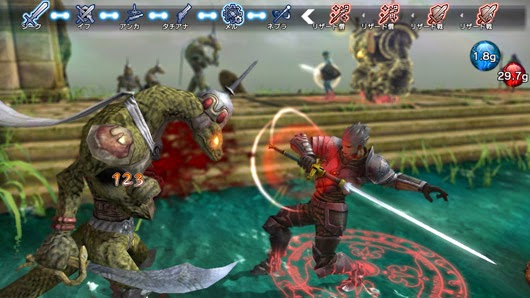 Review by Matt S.
Review by Matt S.
So, let’s talk about Dark Souls (yes, this is a review for different game, but bear with me). In Dark Souls you play as a character that is hopelessly out of his/ her depth in a hellish world of demons and the undead. Slowly but surely, through your expert guidance, this character figures out how to make his/ her way through the world, defeating ever-more powerful creatures and learning new skills along the way. It’s not easy. It’s not even always fun, but it’s rewarding.
Dark Souls is rewarding because the player and his/ her hero come together and learn their way through the game by failing (“dying”). They do this a lot. And this is why I wanted to mention Dark Souls first. What makes is so much fun is a neat segue into Natural Doctrine (NAtURAL DOCtRINE, but in the review I’ll be using standard English for the title), the maiden game from Kadokawa Games’ own development studio. In Natural Doctrine you’ll see the “Game Over” screen over, and over, and one more “over” for good measure, again. I like to think I’m a pretty smart dude (after all, without boasting or anything, I have got a book being published next year). I also like to think I’m pretty good at the whole strategy game genre – I’ve clocked everything from Fire Emblem Awakening to Europa Universalis IV on the highest difficulty settings possible. But playing Natural Doctrine I saw the Game Over screen often enough on normal difficulty to find myself curling up into the foetal position, rocking back and forth and wondering if I might need a straitjacket in the near future.
Unforgiving doesn’t begin to describe this turn-based tactical strategy game. It’s unforgiving in an intriguing way, offering a fascinating combat system and a truly brilliant multiplayer mode (which I’ll get to shortly), but it’s the kind of game that is almost instantly going to put 99 per cent of people off. They’re going to start playing, work through a long and not entirely friendly tutorial, get the “Game Over” screen in the very first level and jump on Twitter to rant and rave about how terrible the game is. It doesn’t help that Natural Doctrine has an uninviting sense of aesthetics, either. I get the impression that the developers were gunning for a grim, unforgiving colour palette to complement the gameplay structure, but in practice environments look washed out, and characters are stiffly animated and sport generic designs besides. People will target this presentation when trying to narrow down why they don’t like Natural Doctrine, but in practice after a while the presentation simply fades right into the background and is neither exciting nor offensive. The reality behind any criticism of this game is that this is simply a game that requires patience well beyond the capacity of most people, and you’re not going to have Kadokawa Games’ idea of strategy nailed in your first dozen hours of playing. Until you get to a point where you do feel somewhat competent with the game’s systems, you’re simply not going to enjoy the experience.
Which is what makes it all the more rewarding when you finally figure out how to out strategise your opponents in the game.
I won’t even try and explain the combat system in full, because that will just confuse you if you haven’t actually played the game (I’m not surprised Kadokawa Games failed to create a decent tutorial for this game). Instead, I’ll just do a quick comparison to the core gameplay loop of a game that you have probably played, like Fire Emblem or XCOM or any of the innumerable other tactical level strategy games out there. In Fire Emblem you select a character, move them to a spot on the map, and then attack an enemy with one of their skills. So far it’s pretty straightforward, right? Well, in Natural Doctrine multiple characters can occupy a single space on the map (up to four human-sized characters, two large enemies, or one giant enemy, for example). Further, it’s important to move these characters as units, because when they attack they will then link up with one another and swarm the enemy. Or, alternatively, it’s possible to hold one in reserve with a “wait” command, and then if the smaller swarm kill the next enemy in the initiative cycle through their attacks that waiting character will jump to next in line for a turn, potentially allowing for even more link attacks with characters that have already had their turns. Confused? Well, this is the most basic of Natural Doctrine’s systems.
With practice it slowly, painfully starts to make sense, and then it becomes evident that Natural Doctrine is a game about a couple of core tactical concepts. Firstly, positioning is vital because ranged units and mages are incredibly weak, but front line units are able to block enemies from reaching them by occupying key “squares” on the battlefield. Geography plays a role too, with the old truism that the army sitting on the hill has the strategic advantage ringing true here as well. Teamwork is vital because even the weakest of goblin enemies will be able to take down your most powerful fighter if you send him to the frontline without support. Somehow, despite being a tactical strategy game with only a handful of characters fighting at any one point in time, Natural Doctrine works incredibly well in abstracting down some of the most complex real-world strategy concepts. And, while at first it can be overwhelming and intimidating (there’s a reason generals tend to be old folks… strategy isn’t actually easy in application), it’s also a game worth sticking with because it’s so darned smart.
In so many of the battles of this game I was looking at what seemed like impossible odds at first, but when I finally figured out the right way to move my units and position them on the map (after a few Game Over screens) the elation of an “impossible” victory was not dissimilar to finally overcoming a behemoth in Dark Souls for the first time.
With all the effort that went into crafting a brutally intelligent combat system, it is a pity the narrative isn’t more compelling. It ties hard to delve into some deeper themes – for instance, it introduces a thread of a discussion around imperialism and racism in the idea that goblins are the only ones able to mine an incredibly valuable resource that humans need, but humans, rather than deal peacefully with the goblins, raid their mines for the material instead. It’s noble that the game tries to offer a more thematically-intense narrative than the pulp fantasy of the likes of Fire Emblem, but those noble intentions are let down by amateurish writing and poor pacing that makes it difficult to relate to the characters.
Further, although the battlefields are expertly designed to provide interesting strategic challenges, the wider world environment is nothing more than a menu with icons representing points of interest. The game tries hard to provide the same grim setting that the Souls games I keep comparing it to are so renowned for, but menus, no matter how well designed, don’t build atmosphere. The fundamental failing of the game’s setting and narrative is most evident in one particular moment where a major character dies. It’s meant to be a moment that replicates the emotional impact of similar scenes in games like Xenoblade Chronicles and Final Fantasy VII, but falls sadly flat. Combat also lacks flair, which is no better highlighted than by pointing to a powerful magic attack that is literally a dot of glowing white light that slowly floats to an enemy before a big number pops up on screen to represent a mass of damage.
None of these criticisms necessarily matter though, because Natural Doctrine is a game for the thinking man or woman, and just as it would be missing the point to complain about chess on the grounds of its aesthetics, so too is it missing the point here to consider anything other than the strategic mechanics in play.
As challenging as it is to work through the single player game, it’s in the multiplayer that the game’s mechanics are truly allowed to let fly. Natural Doctrine’s multiplayer plays out like an odd mix of chess and Magic: The Gathering. Players use points that they earn from either logging into the server, or winning matches, to purchase packs of randomised “cards,” each of which represent a unit for the battlefield. They then use these cards to form a skirmish team of up to eight soldiers to take to the battlefield. Each unit has a points rating, and players have a maximum of 50 points to play with, so if you want that really powerful dragon-thing in your team you’re going to need to accept that the rest of the units are going to be little better than fodder. Then you take your team and find someone to test its strength against.
Pitting wits against another player is always going to be more rewarding that the AI, but I am especially impressed with the sheer lengths that Kadokawa Games went to to flesh the multiplayer out. It’s not just a case of taking your heroes from the single player game and pitting them against one another. Rather it’s a fully-featured strategy game in its own right, with loads of content that you’ll not see sticking to the single player game, and that deserves recognition.
There is such variety in the “cards” that there are all kinds of strategies open to players, and while I haven’t spent enough time in the game to be certain there are no completely overpowered team combinations that can’t be beaten, I’m fairly confident that the game is balanced in such a way that there will be a counter to any strategy that a player might use, assuming that you understand the game and its systems to the point where you’re able to execute an effective counter strategy.
That being said Natural Doctrine is such a niche game that I worry about the size of the community. It’s possible that over the longer term the game develops a fierce, if small community of hardcore strategists, but it’s a safer bet that if you’re buying this for the multiplayer to make sure a friend or two also has a copy. In my time in multiplayer I also saw loads of people clearly struggling to understand how the fundamentals work and how to make effective use of their units, and I wonder whether after being annihilated despite having a strong force on paper, they’ll give up on the game completely. The multiplayer has a system whereby it rates the relative strength of a skirmish team (S rank through D rank, essentially), but it also does a very poor job of explaining why some units are so powerful. For example, there’s a skeleton sorcerer I like to use who doesn’t have attacking spells, and is beyond useless as a melee combatant. He is, however, incredibly expensive to recruit into the team, and that’s for one reason: he has an amazing ability that completely turns the tide of a battle… he can effectively turn back the initiative clock and give all my units another go.
For that one ability my skeleton army has ended up with an S-ranking, but in the hands of someone who isn’t intimately familiar with the way the game’s systems work (or a sense of timing on when to use that one ability of the army’s “hero” piece), my skeleton army could easily be beaten by someone with a B-, if not C- rated team, and that can be discouraging to the person using the S-ranking team. It’s impossible to brute force your way through Natural Doctrine’s multiplayer, and while I love it for that, it’s also ultimately the game’s greatest problem: the vast majority of people playing games – especially on consoles – have been conditioned by developers to accept a watered-down idea of strategy where brute force does work (if not is the only strategy that works). Judging from the way I saw many others trying to play, I suspect they were finding their time with the game frustrating.
It’s rare to say a game is more hardcore than something like Disgaea, but that’s what Natural Doctrine is – it’s the most hardcore tactics strategy game you’ll ever play. It’s brutally and unapologetically unforgiving, and yes, it lacks the presentation values and atmosphere that would help people get over the learning curve. But for the patient few who will be willing to give this game the time it demands, Natural Doctrine is going to be an experience with nearly limitless depth and it is, in fact, one of the best multiplayer strategy experiences on any console at the moment.
– Matt S.
Editor-in-Chief
Find me on Twitter: @digitallydownld












